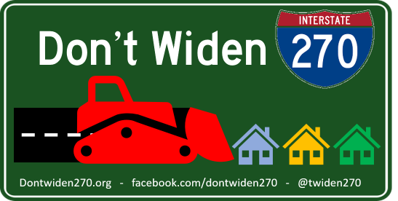The Washington region’s Transportation Planning Board (TPB for short) is asking the public for feedback on future highway projects, including the Moore-Hogan toll lanes.
Our input is key: in May, the TPB will vote to include – or not include – the I-495/I-270 and Southside toll lanes in its long-range plan, called Visualize 2050.
The TPB vote matters because projects like the toll lanes “must be in the TPB plan to receive federal funding and approvals.” MDOT clearly wants a ‘yes’ vote.
But we and our elected allies are asking the TPB to reject the toll lanes with their $50 tolls, worsening congestion for the majority, increased inequity, taxpayer jeopardy, and enormous environmental harm.
The deadline to submit feedback to the TPB is March 30, just days away. The Action Item below takes only a few minutes. Please act now!
Source: Visualize 2050
ACTION ITEM
Let the Transportation Planning Board hear your voice! Using the instructions below, open the TPB feedback form and say ‘no’ to three toll lane projects on I-495 and I-270. You’ll be focusing on Tab 3 and then Tab 5 of the form.
Refer to these navigation steps as you go:
Open the feedback form and click on Tab 3 at the upper right.
You’ll see a map with light brown balloons indicating toll lane projects (“HOV/HOT/Express Lanes”).
The three brown balloons you’re going to process one at a time are:
1) Near Rockville, for the toll lanes from I-270 to I-370;
2) Near the I-270 Y split for the toll lanes from the I-270 West Spur across the American Legion Bridge to the George Washington Parkway; and
3) Near Alexandria for the Southside toll lanes going along I-495 over the Wilson Bridge into Maryland as far as Oxon Hill. (For more about the Southside toll lanes see “Virginia’s Eye on MD” here.)Click on one of the three brown balloons. In the pop-up box, click NO, you do not support the project. Click on the speech bubble next to the NO box to enter a comment.
Then repeat with the other brown balloons.
When you are finished, click on Tab 5, Wrap Up.
If you wish, answer the optional questions. To add any additional comments, click on the speech bubble at the upper right.
Click Finish to submit your form.
Thank you! Please share this Action Item with others.
Quick Update: Lawsuit
As reported by Maryland Matters last week, “A federal judge dismissed a lawsuit…seeking to block a proposed expansion of the Capital Beltway and Interstate 270.” The judge said the plaintiffs “have not demonstrated that defendants’ actions were arbitrary and capricious.”
Per Sierra Club of Maryland Director Josh Tulkin, “This is a disappointing outcome…This project comes with real harms to people and the environment, and MDOT and FHWA ignored important aspects of that harm while reviewing the project.”
The Natural Resources Defense Council, one of the plaintiffs in the case, has said the team “is reviewing the opinion and considering their options.”
Maryland Matters says, “Even with the ruling, the widening project remains at a standstill….it is not clear how or when the project will proceed.”
Our coalition of environmental advocacy organizations, civic and grassroots groups, and elected allies is as determined as ever to oppose the inequitable, destructive Moore-Hogan toll lanes. Thank you, always, for being part of the effort.



